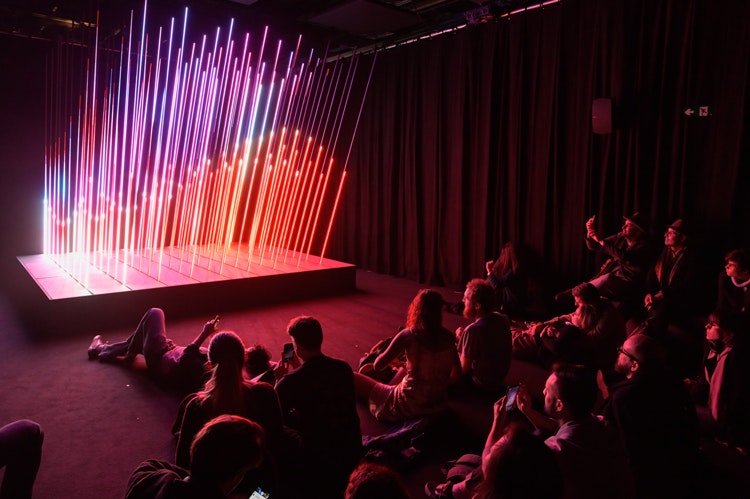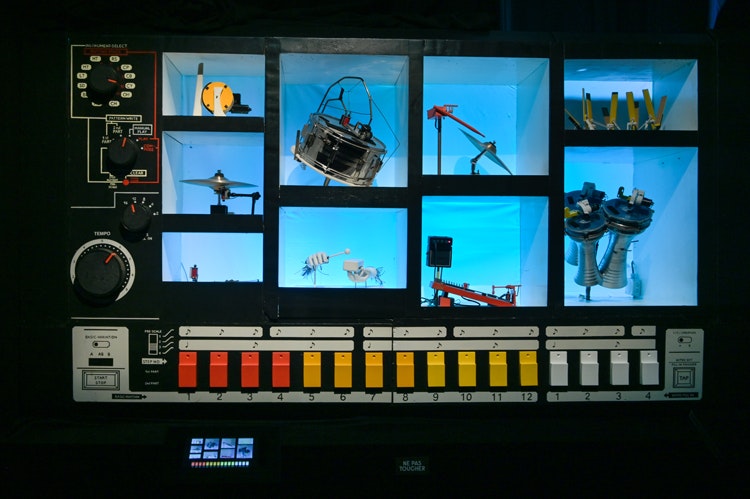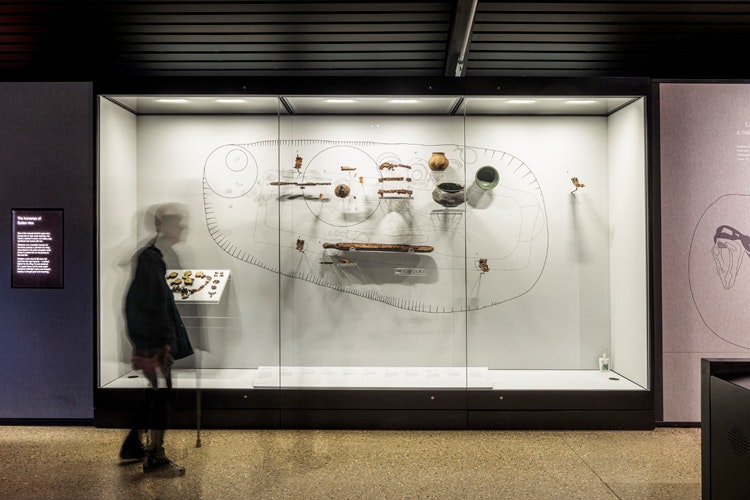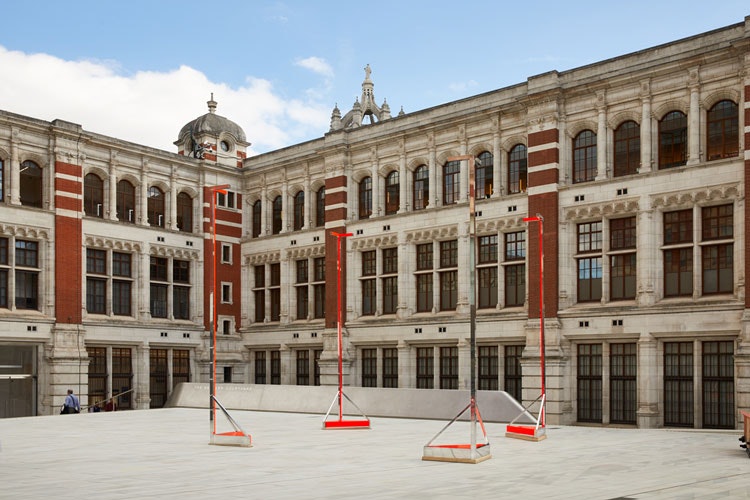The Design Museum was supposed to welcome Kraftwerk and The Chemical Brothers on 1 April. The outbreak of coronavirus put an end to that but not before Electronic: From Kraftwerk to The Chemical Brothers was set up. The London museum’s latest temporary exhibition is a transfer from the Musée de la Musique-Philarmonie de Paris, originally curated by Jean-Yves LeLoup. It will, the Design Museum says, transport visitors through “the people, art, design, technology and photography that have been shaping the electronic music landscape” by evoking the experience of being in a club.
Night clubs, and exhibitions trying to evoke night clubs, are not a viable concept in an age of social distancing. But when the museum partially re-opens on 31 July along with the exhibition, it’s hoped that new measures will keep visitors and staff safe (and provide peace of mind). This will be partly achieved through a new ‘Safe and Sound’ policy which details how the museum is complying with government guidelines. All visitors will wear masks, bike parking capacity has been doubled so that people can cycle more easily to the venue, and there will be hand sanitiser stations.

The museum also aims to halve the number of visitors at the exhibition at any one time. This aim, while safer for visitors and staff, clearly presents problems for ticket sales. To cover the potential shortfall, the venue is opening later into the evening, until 9pm each day. To keep pace, all visits can now only last an hour and a half. Design Museum director of audiences Josephine Chanter says that the time limit is “largely self-regulating”.
The exhibition design has been altered in lockdown to reflect these new needs. All interactive displays, those using iPads for example, have been removed. Any touch screen that would be used by hundreds of people a day is no longer a possibility. Visitors will also need to bring their own headphones for the sound elements of the exhibition. (This move is reminiscent of trends for planes’ in-flight entertainment systems, where the move towards using personal devices is likely going to increase.) There is also now a one-way system throughout the exhibition; there will be no spaces where people can cross paths. This will be aided by floor graphics which encourage social distancing, designed by Studio LP, based in London.
A “more leisurely pace”

The museum’s chief curator Justin McGuirk tells Design Week that the lockdown gave the team an opportunity to “reflect” on how the guidelines would affect the show. “Spatially, a key factor has been to create more space around the objects,” he says. This has meant that certain experiences and objects have been taken out. An “interactive drum experience” has been removed, for example.
McGuirk is hopeful that the changes won’t take away from the experience, but that they might make it “smoother”. “I actually think that one of the possible opportunities is that it creates a slightly more leisurely experience for the visitor,” he says. They could, he believes, reduce crowding and the “pinch points” where visitors crowd around the work. “It could feel more intimate and exclusive.”

When the museum reopens, Electronic will be the only major London exhibition to be opening for the first time, according to McGuirk. There will likely be a period of trial-and-error as institutions work out what is working and what is not. “I’m not assuming we have to rethink exhibitions forever,” McGuirk believes but that it is an interesting “test-bed” for new ideas. “Museums will be watching each other carefully to see what’s working and not working,” he says.
Only Electronic will be open when the Design Museum re-opens. In October, there will be a Margaret Calvert retrospective on the first floor around the balcony galleries. There will likely be a one-way route set in place for the Calvert exhibition. Beazley Designs on the Year opens later in the year, a showcase for innovative design concepts. The exhibition was designed in lockdown and uses a scaffolding to display the projects. Each object gets a 1.5m grid which means that visitors will be conscious of the distancing throughout. “The social distancing is built into the design,” McGuirk adds.
Finding a “linear route”

Nissen Richards studio director Pippa Nissen tells Design Week that she has been working on “designing in” solutions to temporary exhibitions to show clear routes as well as reconfiguring permanent spaces with clearly signposted journeys. Nissen has been working on a wayfinding solution for The Wallace Collection, when the London art venue opens on 15 July. She calls “adjusting a museum to be able to open” a “ridiculously fun” process.
Finding a “linear route” throughout a space is practical for smoother, socially-distancing journeys but it’s also about “making people feel okay”. “As you go into each space, you can gauge your own experience,” she says, meaning that “clear visibility” is crucial. While this type of “spatial configuration” needs to be set in place immediately, Nissen believes that some of these could “spill over” into exhibition design in the longer term.
Wayfinding might not be the only design element affected. COVID could “kickstart a revolution for digital” at exhibitions. The move away from iPads and “low-tech interactives” will see the role of “gesture-controlled interactives” rise, Nissen believes. This would likely include Augmented Reality (AR) and Virtual Reality (VR), and tehcnology’s ability to alter the spaces around visitors. While lockdown has made clear the way that technology makes cultural institutions available in our own bedrooms, the ability to transform grand venues has been a theme in exhibition design for a while, as seen at last year’s London Design Festival.

“Layers of information”
It’s not just about what happens at a venue, but how the entire experience could shift. Nissen suggests that the shift could push towards “layers of information” where the onus is on the visitor to take control. “Maybe you’re collecting things that you delve into more deeply later,” she says. The objects might still be displayed “clearly and beautifully” but there might be less information presented at the exhibition itself. That would of course appeal to social distancing and shorter visiting times, should current lockdown measures continue.
There is likely to be a shift towards even more closely curated experiences. By creating linear routes through familiar spaces, people might encounter spaces differently. But for temporary exhibitions, there will be fewer choices built in. This is echoed by the Design Museum’s Electronic – moments when visitors were presented with a choice throughout the exhibition have been taken out. “It will be much more about experiencing somebody’s pre-thought curated experience than spaces being too full of choice,” Nissen suggests.
A shift for sustainability

Like all sectors of design grappling with a virus that lives on surfaces, materials will be a significant focus moving forwards. Nissen’s team is revisiting longer-term projects and making sure that any material used is “very durable” as it will need to be cleaned often and thoroughly and not be affected. There is an opportunity to be “playful” with this aspect of design if they’re used carefully, like timbers and metals. They can be used visually, for example, and placed out of reach.
All the time spent at home, and in virtual meetings and staring at computer screens, will result in a thirst for materials that show signs of life, Nissen suspects. Whether that’s a metal with an interesting patina or recycled plastics – where you can see that it’s recycled. Nissen Richards likes Richlite, a kind of “compacted paper” which can be cleaned and printed on to give it visual texture. “Anything that isn’t Forex,” she adds.
There could be a wider shift towards sustainabilty in exhibition design, Nissen believes. The studio is working on two or three projects with some clients, and discussing how these incorporate more sustainable features. Designs that can be built, and then adapted for different exhibitions, rather than just changing them each time. The idea of reusing sets in this way was a frequent topic at the preview of this year’s cancelled Salone del Mobile, where designers discussed possible ways to make festivals more sustainable.
“We can’t be as wasteful anymore,” Nissen says. One such idea could be using the centre of a room as an “anchor point” to which a modular design piece could be attached, with the ability to be positioned in different ways. By shifting the model by 90 degrees, you could transform the space, moving from individual rooms to longer corridors, for example. Colour, graphics and layers will also play a big role in adapting spaces, Nissen adds.
Thinking in both short and long-term will be a requirement for designers in the coming months and likely years. As Nissen notes, “there’s a rule one week and a different one the next.” The wayfinding grids that Nissen is working on at the moment could feel “old school” next month. The only thing that seems to be certain is a need to be adaptable.
Electronic: From Kraftwerk to The Chemical Brothers opens 13 July 2020 at the Design Museum, 224 – 238 Kensington High Street London W8 6AG. Tickets start at £16. Please visit the website for details.

- Design disciplines in this article
- Industries in this article
- Brands in this article









